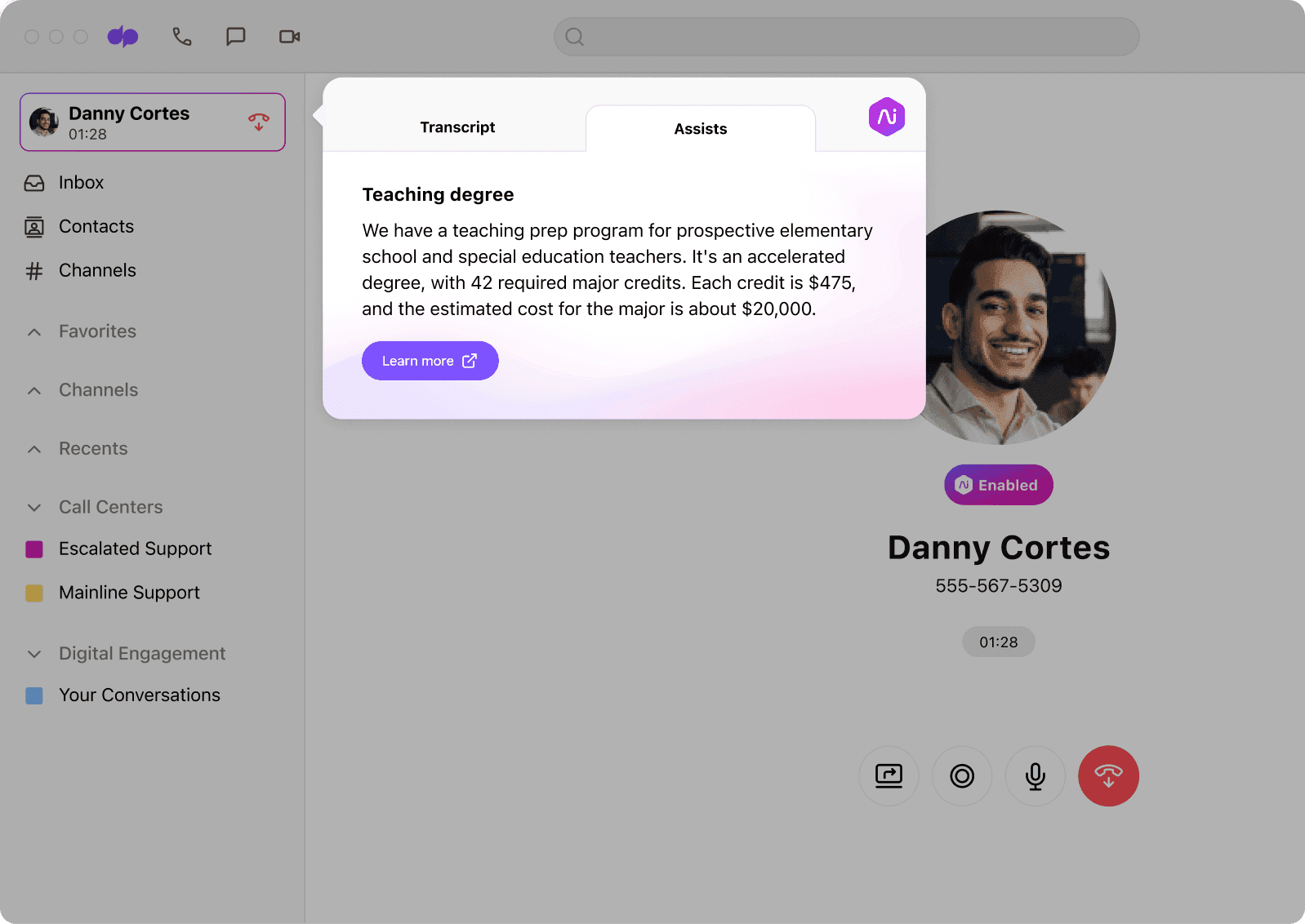Call handling guide and best practices in the UK

Tags
Share
The UK Customer Satisfaction Index (UKCSI) benchmarks customer satisfaction across different types of organisations in a variety of sectors and found that in July 2023, customer satisfaction is currently at the lowest since 2015. Furthermore, another recent study by Microsoft found that call centre wait times in the UK can be up to 85 minutes.
So if you want to provide customers with excellent customer service experience without long wait times, having an effective call handling system is more crucial than ever.
By developing best practices for call handling tailored to the needs of your customers, your business can go above and beyond. In this post, we'll cover the basics of call handling, provide advice for dealing with difficult customers, outline steps for addressing customer complaints, as well as explore the benefits of a comprehensive system.
Understanding the basics of call handling in the UK
Call handling is the process of managing customer interactions in a professional and efficient manner. In the UK, businesses must adhere to legal and regulatory frameworks when handling customer calls. Understanding these laws and regulations is essential for providing quality service, as well as avoiding costly penalties or damages.
Customer service is also an important component of call handling. Businesses must create a positive experience for customers that meets their expectations and encourages them to come back for more. In order to achieve this, you need to understand the key elements of effective call handling, such as creating a welcoming atmosphere, speaking clearly and politely, active listening skills, problem-solving abilities, and being able to empathise with customers
Examples of good call handling include:
taking responsibility for any issues or complaints that arise on calls
providing helpful advice or solutions where possible
following up with customers after conversations are completed, and
using appropriate language throughout the conversation.
Conversely, bad call handling can be demonstrated by not addressing customer issues promptly or properly, displaying poor communication skills (such as talking over customers), not listening carefully enough to understand the issue at hand, or being overly aggressive in tone during interactions.
Finally, there are both opportunities and challenges associated with call handling. Having an effective system in place can help businesses improve customer satisfaction ratings while reducing costs associated with customer service operations. On the other hand, if not handled correctly calls can lead to negative experiences that damage relationships between customers and businesses, resulting in lost revenue and long-term damage to reputation.
Developing call handling etiquette and best practices
The UK has a strict set of customer service standards and expectations that businesses must meet in order to provide an excellent experience. Developing call handling etiquette and best practices is the first step in achieving this. Here are some key tips to help you improve your customer service:
1. Provide a pleasant and helpful tone when taking calls: Customers appreciate agents who are warm and welcoming when they pick up the phone. Taking a few seconds to introduce yourself, thank the caller for their time, and explain what you can do for them can make all the difference in creating a good first impression.
2. Actively listen to customers: Active listening involves paying attention to what the customer tells you, asking relevant questions, repeating back what the customer says so they know you understand them, and summarizing their request or issue at regular intervals throughout the conversation. This helps ensure that both sides have a clear understanding of the situation before moving on with finding solutions or resolving issues.
3. Respond with empathy: It's important to show empathy during conversations with customers as it demonstrates respect for how they feel about their request or issue at hand. Showing understanding can also help build trust with customers and make them more likely to return in future interactions.
4. Manage customer enquiries and complaints: Everyone encounters complaints from time to time, but it's important not to take them personally as it can be hard to remain objective during heated conversations with customers. Remain calm during such situations, apologize sincerely if necessary, offer solutions if possible, suggest preventative measures wherever appropriate, document all conversations accurately, and follow up promptly once an issue is resolved – these are just some ways you can successfully manage customer enquiries or complaints effectively while maintaining good relationships with your customers.
5. GDPR compliance: The General Data Protection Regulation (GDPR) is designed to protect individuals' privacy rights by requiring companies collecting data about EU citizens (including recordings of calls) to obtain explicit consent from those individuals whenever data is collected or processed in any form – including verbal recordings of calls made by customers within the EU region. We've written about call recording and GDPR compliance in detail, but to summarise, when recording calls made by EU-based customers, businesses need to clearly state that they will be recording this call prior to beginning any conversation — by law. Additionally, businesses should store recorded conversations safely, ensuring that only authorized personnel have access.
These guidelines on developing call handling etiquette and making sure your team is properly trained will demonstrate high levels of professionalism of your organisation. These steps will also ensure compliance with national regulations such as GDPR, create positive relationships with clients, promote loyalty among existing customers, encourage repeat purchases from returning customers, and ultimately foster growth within organisations.
Tips for dealing with difficult customers
Since customers may be calling your business when they've encountered and issue and are feeling frustrated, the key in these types of situations is to remain composed and professional.
Listening intently without interruption, asking questions for greater clarity on their dissatisfaction, and replying with understanding and compassion are all critical factors in this process. Depending on the situation, it's also essential to explain any relevant policies, protocols, or regulations. This will help ensure that customers feel heard and respected.
In addition, presenting solutions and alternatives can often help alleviate potential conflicts or miscalculations. This means going beyond a simple apology for the customer's experience and exploring options that can make amends or provide tangible resolution is necessary as well. Offering other services or products that may be beneficial or discounts could also prove beneficial when striving to settle an argument.
Finally, don't forget the significance of follow-up communications after a trying customer interaction has been completed. Making contact with an email or phone call afterwards reveals to customers that their issue was taken seriously and managed properly. Ultimately, this helps strengthen the trust between your business and your consumers for future interactions. With these tips for coping with difficult customers, your business can be better prepared for whatever situation they may face.
Addressing customer complaints
Sometimes, customers may contact you to complain about a service or product. Addressing customer complaints requires a few key steps for successful resolution of issues.
Firstly, it's important to listen intently and actively to customer concerns, asking questions for understanding. This shows that their complaint has been heard and understood.
Secondly, take ownership of the problem (even if you didn't cause it) and apologise for any inconvenience caused. Thirdly, provide relevant solutions or alternatives if possible, such as refunds, exchanges or product suggestions, along with an estimated timeline if immediate resolution cannot be provided.
Fourthly, keep records of all conversations related to the complaint as well as details about any solutions offered or actions taken by your organisation. This will help should similar issues arise in future. Lastly, follow up with customers after resolving issues to check satisfaction levels and confirm complete solution of the issue.
Benefits of a comprehensive call handling system
Now that you have a better understanding of how to answer different types of calls, including difficult conversations and complaints, it's important to also understand the benefits of using a comprehensive call handling system. Software like Dialpad can help reduce operational costs, improve employee morale and job satisfaction, enhance customer loyalty, and potentially achieve a high return on investment.
When looking for a modern call handling system, you should consider features such as automated call routing, analytics, and AI-powered capabilities such as real-time assist, which is designed to help your agents answer tough questions or provide boilerplate scripts as needed. These types of features can help you maximize the effectiveness of your call centre and ensure that your customers have the best experience possible.

You should consider what types of features would benefit your team and empower them to respond quickly to all customer enquiries and complaints—while maintaining a consistent level of quality and professionalism. For example, keeping an eye on different metrics such as your CSAT score (customer satisfaction score) and average handle time (AHT) can ensure that all calls are handled with the same standards of efficiency and effectiveness by introducing standardised processes across departments.
Moreover, having a comprehensive call handling system also allows businesses to streamline their operations. Enabling customer callback helps reduce wait times for customers by allowing them to be called back at a later time and not have to wait on the line for an hour or more.
The right call handling system can also beneficial for your employees as it provides them with clear job expectations and duties. Combined with regular training, this helps them understand their roles better while setting up achievable goals that they can work towards achieving. Understanding why customers are calling and then providing employees with clear guidelines on how different types of calls should be handled ensures that customers receive satisfactory responses from agents.
There's also long-term benefits for your organisation too. By improving customer satisfaction levels through efficient service, this fosters strong relationships between clients and employees, which results in customer loyalty while potentially gaining new ones through referrals or word of mouth recommendations from satisfied clients. Proper call handling can lead to higher returns on investments over time due to increased sales or services rendered through improved customer relations management strategies.
Happier calls, happier customers
Call handling is not just making sure that callers have a good experience when contacting your organisation. It's also about understanding why customers are calling and providing your employees with clear guidelines on how to handle different types of calls. With the different steps provided, you can develop best practices for your business that also aligns with your brand and how you want your customers to be treated. If you want satisfied customers and increased customer loyalty, it's important to regularly revisit your team's call handling process and monitor call centre KPIs like CSAT.
Better call handling starts with Dialpad
With Dialpad's AI-powered customer engagement solution, you can make phone calls, have video meetings, send SMS/MMS messages, and more—all from a single app. Try it for free, or take a self-guided interactive tour of the app first!
